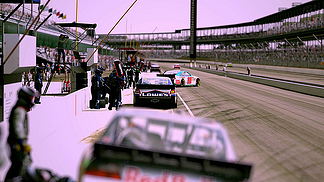3 Rules for Communicating with Your Child
3 min read
Date Published: 10/17/2012
Last Updated: 06/11/2018
National Fatherhood Initiative Blog / Latest Articles
3 min read
Odds are good you didn’t wake up this morning and say to yourself, “You know, I should communicate with my kids better…or more…” No, that has never happened - EVER.
Something must change in how we view communication. We understand the importance of communication, but we need something to help us remember that how we do it daily is of utmost importance.
I say we stop calling “communication” by its name. Let’s call it “racing.” Yes, as a NASCAR fan, I’m saying let’s reframe our ideas about what communication is and change the very term “communication” to “racing.” There are three rules the best racecar drivers follow, and they apply very well to communicating with your children. And if you don’t know much about racing – that’s okay. You will now!

Here are the rules:
1) Know your racetrack.
How you race depends greatly on the track. Professional racecar drivers know there are four types of racetracks, and they treat each track differently - mainly because each track requires exact and strategic expertise. Likewise dads, the age or “track” your child is on will change the words you use to communicate. Consider applying the four different racetracks to the age/stage of your child as follows:
Short tracks = Infants and young kids
Intermediate tracks = School-aged children
Superspeedways = Teenagers
Road Courses = College-aged children and beyond
Dads, we must become track experts in relating to the stage of our children, so learning to speak effectively and correctly to your child is important on a daily basis. For instance, the younger the child, the shorter and simpler the sentence should be. Instead of asking your three year old, "Why did you do that?" which wouldn’t even be easy if you were 35 years old; try saying, "Let's talk about what you did." Consider saying to your child, “Pick up your shoes, please.” Instead of, “will you please pick up your shoes?” The difference from question to directive is the difference from clear to unclear communication... er, uh, racing.
Also, as children get older, try asking them to repeat whatever your wanting them to do back to you. For instance, you may be angry your teen isn’t doing what you want, but it may simply be that your message or ask is unclear. In general, if your child can’t repeat your directive back to you, change the way you present the directive to meet them on their “track.”
2) Practice, practice, practice. And then practice more.
When a NASCAR driver isn’t on the track, he is practicing. A driver’s life is about way more than that short moment on the racetrack. And all of his time leading up to the moment on the track is spent in preparation. When is the right time to practice? Early and often. Just like most professional drivers raced cars when they were young, you too must be intentional about talking and spending time with your child early and often.
It’s never too early to start talking and listening to your children. Spend time with them and be purposeful in what you do during your moments together. We have ideas of things to do in a recent post called 7 Ways To Connect With Your Kidsfrom eating a meal together, reading books together, dad-kid Dates, and game nights. The point is to look for opportunities to practice. Seize every moment to practice. For young kids, read to your child. Even if your child is too young to talk, trust us, what you do as a father early on builds the relationship.
3) You must make adjustments.
If Nascar drivers know anything beyond the track and practicing; they understand the importance of making adjustments. Adjustments are crucial in racing. Likewise, you as a dad will learn by trial and error. It’s good to understand you can learn both when you’re away from your child and during the moments you are with them. Great drivers know the importance of making adjustments, from “Research and Development” to “The Pit Box.”
Research and development for Nascar is the science behind the actual racing. If you toured a NASCAR research facility, you wouldn’t see the driver and the car together. Likewise dad, you will need to study your child, even when you aren’t in the same room as your child. When you aren’t with your child, whether at work or on travel, or simply talking to other parents, consider this time to learn more about connecting with your child.
During a race, drivers know the importance of making adjustments in the pit box. All the practice and time has lead to the moment with the car on the track. Now, there is still time to make last-minute adjustments. Consider this, in that moment when you don’t think you’re connecting; get down on their level. Make eye contact and be intentional about showing your child that he or she has your full attention.
Basically, dads are racecar drivers. How you race depends on your knowledge and skill of the track, the amount of time you practice, and the amount of effort you use to make adjustments. Remember, “communication” is old language. Let’s go racin’, boys!
Date Published: 10/17/2012
Last Updated: 06/11/2018
Download the ebook to learn how to create fatherhood initiatives that engage every sector of community life.

Train Your Staff
Fatherhood Programs
Fatherhood Data
© 2025 National Fatherhood Initiative®. All rights reserved.